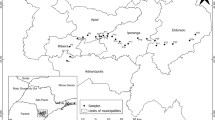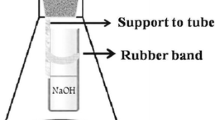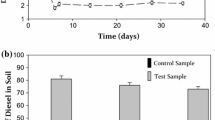Abstract
Sandy clay loam soil was contaminated with 5000 mg kg−1 diesel, and amended with nitrogen (15.98 atom% 15N) at 0, 250, 500, and 1000 mg kg−1 to determine gross rates of nitrogen transformations during diesel biodegradation at varying soil water potentials. The observed water potential values were −0.20, −0.47, −0.85, and −1.50 MPa in the 0, 250, 500, and 1000 mg kg−1 nitrogen treatments respectively. Highest microbial respiration occurred in the lowest nitrogen treatment suggesting an inhibitory osmotic effect from higher rates of nitrogen application. Microbial respiration rates of 185, 169, 131, and 116 mg O2 kg−1 soil day−1 were observed in the 250, 500, control and 1000 mg kg−1 nitrogen treatments, respectively. Gross nitrification was inversely related to water potential with rates of 0.2, 0.04, and 0.004 mg N kg−1 soil day−1 in the 250, 500, and 1000 mg kg−1 nitrogen treatments, respectively. Reduction in water potential did not inhibit gross nitrogen immobilization or mineralization, with respective immobilization rates of 2.2, 1.8, and 1.8 mg N kg−1 soil day−1, and mineralization rates of 0.5, 0.3, and 0.3 mg N kg−1 soil day−1 in the 1000, 500, and 250 mg kg−1 nitrogen treatments, respectively. Based on nitrogen transformation rates, the duration of fertilizer contribution to the inorganic nitrogen pool was estimated at 0.9, 1.9, and 3.2 years in the 250, 500, and 1000 mg kg−1 nitrogen treatments, respectively. The estimation was conservative as ammonium fixation, gross nitrogen immobilization, and nitrification were considered losses of fertilizer with only gross mineralization of organic nitrogen contributing to the most active portion of the nitrogen pool.
Similar content being viewed by others
References
Alexander M, (1999) Biodegradation and Bioremediation 2 Academic Press, Inc. San Diego, CA
Bistrow AW, Ryden JC, Whitehead DC, (1987) The fate at several time intervals of 15N-labeled ammonium nitrate applied to an established grass sward J. Soil Sci. 38: 245–254
Bjarnason S, (1988). Calculation of gross nitrogen immobilization and mineralization in soil J. Soil Sci. 39: 393–406
Braddock JF, Ruth ML, Catterall PH, Walworth JL, McCarthy KA, (1997) Enhancement and inhibition of microbial activity in hydrocarbon-contaminated arctic soils: implication for nutrient-amended bioremediation Environ. Sci. Technol. 31(7): 2078–2084
Breitenbeck GA, Paramasivam S, (1995) Availability of 15N-labeled nonexhchangeable ammonium to soil microorganisms Soil Sci. 159(5): 301–310
Bremner JM, Mulvaney CS, (1982) Nitrogen-Total In: Page A.L., et al. (eds) Methods of Soil Analysis American Society of Agronomy Madison WI pp.595–624
Buswell JA, (1994) Potential of spent mushroom substrate for bioremediation purposes Compost Sci. Utilization 2(3): 31–36
Chang ZZ, Weaver RW, (1997) Nitrification and utilization of ammonium and nitrate during oil bioremediation at different soil water potentials J. Soil Contamin. 6(2): 149–160
Davidson EA, Hart SC, Firestone MK, (1992) Internal cycling of nitrate in soils of a mature coniferous forest Ecology 73(4): 1148–1156
Diaz MP, Grigson SJW, Peppiatt C, Burgess JG, (2000) Isolation and characterization of novel hydrocarbon degrading euryhaline consortia from crude oil and mangrove sediments Mar. Biotechnol. 2:522–532
Drury CF, Beauchamp EG, (1991) Ammonium fixation, release, nitrification, and immobilization in high and low fixing soils Soil Sci. Soc. Am. J. 55: 125–129
Geerdink MJ, van Loosdrecht MCM, Luyben KChAM, (1996) Biodegrability of diesel oil Biodegradation 7: 73–81
Haines JR, Kadkhodayan M, Mocsny DJ, Jones CA, Islam M, Venosa AD, (1994) Effect of salinity, oil type, and incubation temperature on oil degradation In: Hinchee R.E., Anderson D.B. Jr, Metting F.B., Sayles G.D., (eds), Applied Biotechnology for Site Remediation Lewis Publishers Boca Raton pp.75–83
Han SO, New PB, (1994) Effect of water availability on degradation of 2,4-dichlorophenoxyacetic acid (2,4-D) by soil microorganisms Soil Biol. Biochem. 26(12): 1689–1697
Hart SC, Stark JM, Davidson EA & Firestone MK (1994) Nitrogen mineralization, immobilization and nitrification. In: Weaver RW, et al. (Eds) Methods of Soil Analysis, Part 2. Microbiological and Biochemical Properties (pp. 985–1018). Soil Science Society of America, Madison WI
Hauck RD, Bremner JM, (1976) Use of tracers for soil and fertilizer nitrogen research Adv. Agron. 28: 219–260
Holden PA, Halverson LJ, Firestone MK, (1997) Water stress effects on toluene biodegradation by Pseudomonas putida Biodegradation 8: 143–151
Keeney DR, Nelson DW, (1982) Nitrogen-Inorganic Forms In: Page A.L. et al. (eds), Methods of Soil Analysis, Part 2. Chemical and Microbiological Properties American Society of Agronomy Madison WI pp. 648–658
Khan SA, Mulvaney RL, Brooks PD, (1998) Diffusion methods for automated nitrogen−15 analysis using acidified disks Soil Sci. Soc. Am. J. 62: 406–412
Kirkham D, Bartholomew WV, (1954) Equations for following nutrient transformation in soil using tracer data Soil Sci. Soc. Am. Proc. 18:33–34
Maier RM, Pepper IL, Gerba CP, (2000) Environmental Microbiology Academic Press San Diego, CA
Malhi SS, McGill WB, (1982) Nitrification in three Alberta soils: effect of temperature, moisture and substrate concentration Soil Biol. Biochem. 14:393–399
McGee EA, Vohman DD, White SA, Thompson TL, (1999) Rapid method for fine grinding soils for organic nitrogen and 15nitrogen analysis Commun. Soil Sci. Plant Anal. 30(3&4): 419–426
Mulvaney RL, Fohringer CL, Bojan VJ, Herzog LF, (1990) A commercial system for automated nitrogen isotope-ratio analysis by the Rittenberg technique Rev. Sci. Instrum 61: 897–903
Paul EA, Clark FC, (1989). Soil Microbiology and biochemistry Academic Press San Diego
Rhykerd RL, Weaver RW, McInnes KJ, (1995) Influence of salinity on bioremediation of oil in soil Environ. Pollut. 20(1): 127–130
Shapir N, Mandelbaum RT, Gottlieb H, (1998) Atrazine degradation in saline wastewater by Pseudomonas sp strain ADT Soc. Industr. Microbiol. 20: 153–159
Stark JM, Firestone MK, (1995) Mechanisms for soil moisture effects on activity of nitrifying bacteria Appl. Environ. Microbiol. 61: 218–221
Trehan SP, (1996) Immobilization of 15NH +4 in three soils by chemical and biological processes Soil Biol. Biochem. 28: 1021–1027
Volker R, Kleinsteuber S, Babel W, (2003) Influence of high salinities on the degradation of diesel fuel by bacterial consortia Can. J. Microbiol. 49: 713–721
Walecka-Hutchison C & Walworth JL (2001) Hydrocarbon biodegradation rates and water potential in nitrogen augmented desert soils. In: Leeson A, et al. (Eds) Bioremediation of Inorganic Compounds: Nitrogen Removal and Nitrogen-Enhanced Biodegradation 6(9), pp 231–239. Battelle Press, Columbus, OH
Walworth JL, Reynolds CM, (1995) Bioremediation of a petroleum-contaminated cryic soil: effects of phosphorus, nitrogen, and temperature J. Soil Contamin. 4(3): 299–310
Walworth JL, Woolard CR, Braddock JF, Reynolds CM, (1997a) Enhancement and inhibition of soil petroleum biodegradation through the use of fertilizer nitrogen: an approach to determining optimal levels J. Soil Contamin. 6(5): 465–480
Walworth JL, Woolard CR, Braddock JF, Reynolds CM, (1997b) The role of soil nitrogen concentration in bioremediation Bioremediation 4(4):283–288
Welsh DT, Lindsay YE, Caumette P, Herbert RA, Hannan J, (1996) Identification of trehalose and glycine betaine as compatible solutes in the moderately halophilic surface reducing bacterium, Desulfovibrio halophilus FEMS Microbiol. Lett. 140: 203–207
Zaman M, Di JJ, Cameron KC, Frampton CM, (1999) Gross nitrogen mineralization and nitrification rates and their relationships to enzyme activities and the soil microbial biomass in soils treated with dairy shed effluent and ammonium fertilizer at different water potentials Biol. Fertil. Soils 29: 178–186
Author information
Authors and Affiliations
Corresponding author
Rights and permissions
About this article
Cite this article
Walecka-Hutchison, C., Walworth, J. Evaluating the effects of gross nitrogen mineralization, immobilization, and nitrification on nitrogen fertilizer availability in soil experimentally contaminated with diesel. Biodegradation 18, 133–144 (2007). https://doi.org/10.1007/s10532-006-9049-7
Received:
Accepted:
Published:
Issue Date:
DOI: https://doi.org/10.1007/s10532-006-9049-7




